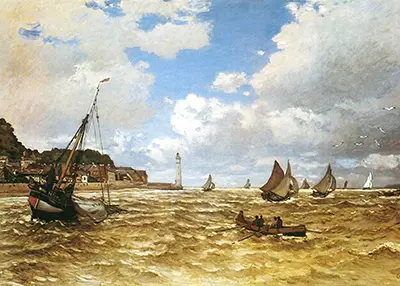This time, Monet was painting a rather dramatic depiction of boats on the wide mouth of the River Seine which runs through Paris.
Claude Monet was a French Impressionist painter and he lived between 1840 and 1926. Monet was particularly interested in painting landscapes, and his Waterlily series is one of the most famous depictions of the French countryside.
Mouth of the Seine at Honfleur is an interesting picture because it was painted relatively early in Monet's career - in 1865 when he was just 24-25 years of age.
As such, it was painted before Monet had completely developed and matured his notable and very unique and instantly recognisable Impressionist style of painting.
However, the seeds of this style can be seen in Mouth of the Seine at Honfleur. A beautiful painting in its own right, Mouth of the Seine at Honfleur is also significant, then, because it foreshadows the great painter that Monet was to become.
Mouth of the Seine at Honfleur is painted in a much more realist style than Monet's later art works (such as his aforementioned Waterlilies series). The boats on the water and the gulls overhead - even the waves - are defined clearly with strong black lines.
This contrasts to the softer tones and more blurred and impressionistic lines that would characterise his later works, including a series of highly dreamlike and impressionistic paintings of the Seine that he would complete later in his career.
We might see the influence of the French realist school of painting known as the Barbizon school in Mouth of the Seine at Honfleur. The Barbizon school developed a realistic painting style that was very much focused on capturing the French rural landscape.
The Impressionists, including Monet, owed a lot to the Barbizon school even though Impressionism takes a very different approach to applying paint on canvas. Both schools were interested in loosely applying oil paint in a way that evoked the unique quality of light at particular times of day.
Both schools, moreover, were very interested in painting 'en plein air' (French for 'in the open air' or 'al fresco') so that they could capture this unique quality of atmosphere and light in the most immediate way possible.
As an early work by Monet, Mouth of the Seine at Honfleur is very dramatic and dynamic. Viewers can sense the choppy motion of the water, and imagine the constant movement of the boats that rest upon it.
This is also in contrast to the more stolid structures in the background, suck as the lighthouse which the viewer's eye will eventually pick out as it explores the painting. By foregrounding movement in this fashion in Mouth of the Seine at Honfleur, Monet brings us into the immediate moment.
This immediacy is a very important part of the Impressionist en plein air style, and it is one way in which we can see seeds of the later Monet in this early work.
Another way in which Mouth of the Seine at Honfleur foreshadows Monet's later style is in the sheer vividness of the colours.
Like many Impressionist painters, Monet did not mix his paints to lighten or temper their hues, he just applied them right from their tube to the canvas. The result is something which instantly grabs our attention due to the exclamatory colours.


